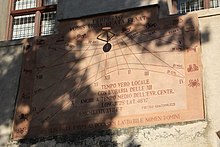Era fascista


The Era Fascista (Fascist Era) was an annual count in Fascist Italy . The first day, the epoch , of Anno I (year 1) of the Era Fascista marked the swearing-in of Mussolini as President of the Council of Ministers on October 29, 1922 after the march on Rome . Model of the era Era Fascista was the republican calendar of the French Revolution of the 1,792th
The new census was presented in a circular from the Prime Minister on December 25, 1926, and on October 29, 1927, the obligation came into force to add the date of the fascist era to the usual date. It was intended to replace the "civil" Gregorian date in the Italian public. It got to the point that in 1939 newspapers were banned from reporting on New Year's Day .
Each year of the Era Fascista was an Anno Fascista, abbreviated AF. A date of the Era Fascista consists of the Gregorian date, followed by the corresponding year of the Era Fascista in Roman numerals , as the fascist propaganda sought the reference to the Roman antiquity of the imperial era. The year of the Era Fascista was written as Anno XIX, A. XIX or with the addition EF .
The tenth anniversary of the March on Rome in Anno X was based on the Roman Decennalia , the celebration of the ten year reign of an emperor, decennale called. The propaganda highlight of Anno X was the exhibition Mostra della Rivoluzione Fascista in Rome. To celebrate the second decennale, the Anno XX, which was World Expo Esposizione Universale di Roma planned in Italy, but no longer took place because of the war.
The calendar lost all meaning with the fall of fascism in 1943 ( Anno XXI ) resp. 1945 in the Italian Social Republic of Salò , but to this day many buildings and monuments in Italy still bear the data of the EF.
swell
- ^ Philip V. Cannistraro: Mussolini's cultural revolution: fascist or nationalist? In: Roger Griffin , Matthew Feldman (Eds.): Fascism: Critical Concept in Political Science. Vol. 3: Fascism: Fascism and Culture. Pp. 183-203, p. 194.
- ^ Edgardo Baldi, Aldo Cerchiari: Enciclopedia moderna italiana. P. 1306.
- ↑ Simonetta Falasca-Zamponi: Fascist Spectacle: The Aesthetics of Power in Mussolini's Italy. 2000, p. 105.
- ^ Adriano Cappelli : Cronologia, cronografia e calendario perpetuo. Hoepli, 1998, p. 131.
- ^ Matthew Kneale: Rome: A History in Seven Sackings. Simon and Schuster, 2018, p. 296.
- ^ Catherine E. Paul: Fascist Directive: Ezra Pound and Italian Cultural Nationalism. 2016, p. 114.
- ^ B. Painter: Mussolini's Rome: Rebuilding the Eternal City. 2016, p. 26.
